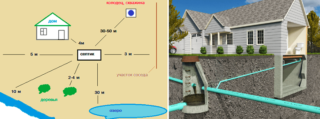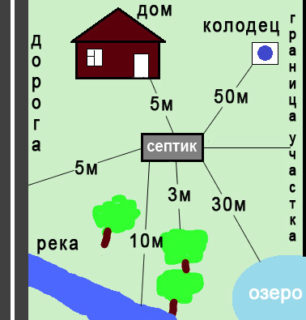The population of our country lives both in cities and outside them. In order for life and rest outside the city to be comfortable, it is necessary that there are utilities on the site, in particular, water and a wastewater disposal system. To do this, in suburban areas, individual water wells are drilled and local sewerage systems are installed. The main thing when carrying out these works is not to violate the installation rules, to observe the regulated distance between the water source and the septic tank, so as not to harm yourself and others.
Septic tank: what is the danger
Waste drained into a septic tank contains many substances that can poison the environment if released into it. These are household chemicals, feces, waste, food and other waste. And, in the event of an accident, when sewage enters the soil, it becomes toxic, unsuitable for growing any kind of garden or vegetable garden crops. If the distance from the treatment plant to the foundation of a residential building is less than the one laid down by SNiP, then, in the event of a depressurization of the device and a leak, it is possible to wash and destroy the foundation, and with it the house. And the smell that appears in the house when a septic tank is improperly installed can bring a lot of trouble.
When planning a site and choosing the optimal place for installing a sewage station, the most important thing is to carefully observe the standards for the distance from the septic tank to the water intake well so that possible wastewater leaks do not reach the water horizons and do not infect or poison the drinking water. In case of such an infection, water cannot be consumed, there is a great risk of severe poisoning. Such poisoning is especially dangerous for children, when it may come to hospitalization of those poisoned.
Basic installation rules
- SNiP 2.04.03-85;
- SNiP 2.04.01-85;
- SanPiN 2.2.1 / 2.1.1.1200-03;
- SanPiN No. 2.1.5.980-00.
According to sanitary regulations, there must be a distance of at least:
- To the foundation of the house - 5 meters or more. But it should be borne in mind that a significant increase in this distance complicates the creation of a slope for a gravity drain system and can lead to complex blockages.
- To the border of the plot with a road embankment - 5 m
- To the vegetable garden and garden - 5 m
- To outbuildings on your own plot - 1 m
- To the neighboring site - 2 m, if there are no objects, buildings, wells, sheds or other communications on this site, if they are present, then the distance is considered from them, and not from the fence
- To the gas pipe - 5 m
- To a pond or lake - 30 m
- To a stream or river - 10 m
- And the most important distance - to the well or well - 20-80 m
The distance that should be from the septic tank to the well is determined by several parameters - the design of the septic tank, the type of well, the slope of the site, the depth of the aquifer, the composition of the soil.
For artesian wells in dense clay or stone soils that are poorly permeable to water, this distance is 30 m - deep-lying waters, separated from the overlying groundwater impermeable layers, are well protected from possible pollution and contamination from septic tank wastewater. For wells "on the sand" drilled in sandy, crushed stone, rather loose soils that easily pass water, the distance to treatment facilities is 50 m - the water in them, fed from high-lying aquifers, is not protected from possible pollution.
When installing a septic tank in clay soil, it is permissible to maintain a minimum distance of 20 m. Loam forces this distance to be increased to 35 m, and with sandy loam or sandy soil, which perfectly passes water, the distance should be as large as possible, up to 50-80 m. In practice owners of land plots try to locate sewage facilities as far as possible from wells and wells.
How to influence regulations
Instead, you can put a sealed storage tank, most often they are made of durable plastic. The size and shape of the storage device is selected depending on the parameters of the installation site, the intensity of water consumption, and, accordingly, the drainage and the number of people living. The container itself is inexpensive, but you will have to regularly pay for the pumping of wastewater by sewers.
It may be worth purchasing a biological aerobic or anaerobic station with a complete water purification system using a special type of bacteria. The distance requirements for the installation of such a station to objects are completely different, which allows it to be used in small areas. But the price of this type of septic tank is quite high, it is also worth noting its inability to work autonomously, since electricity is required for its full-fledged activity.
Conclusion
The distance from the water intake to the place of wastewater localization must be strictly at least 20 meters. Neglecting this condition when constructing water intake and sewerage facilities exposes users of the water source to the risk of poisoning.
Failure to comply with the requirements of SNiP may entail penalties from the SES and even a ban on the use and forced dismantling of an incorrectly installed septic tank. And in case of water contamination and harm to the health and property of citizens, liability can come up to criminal.











